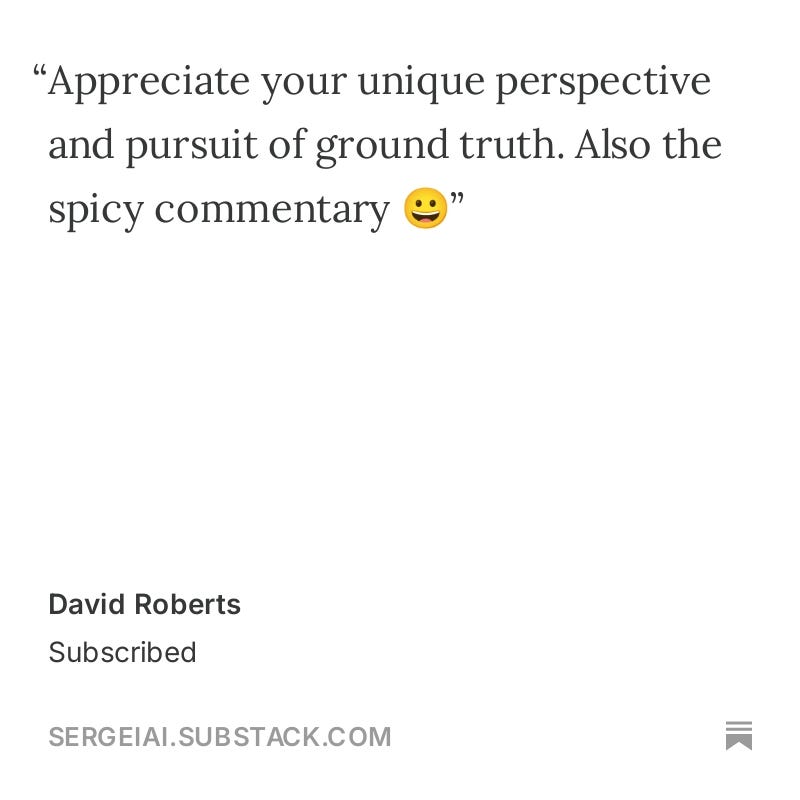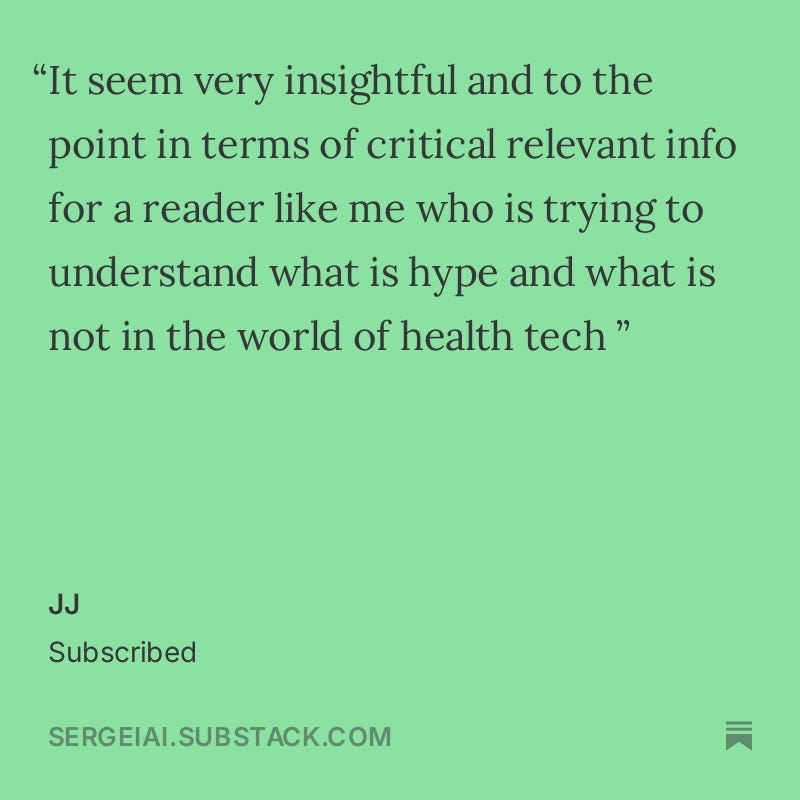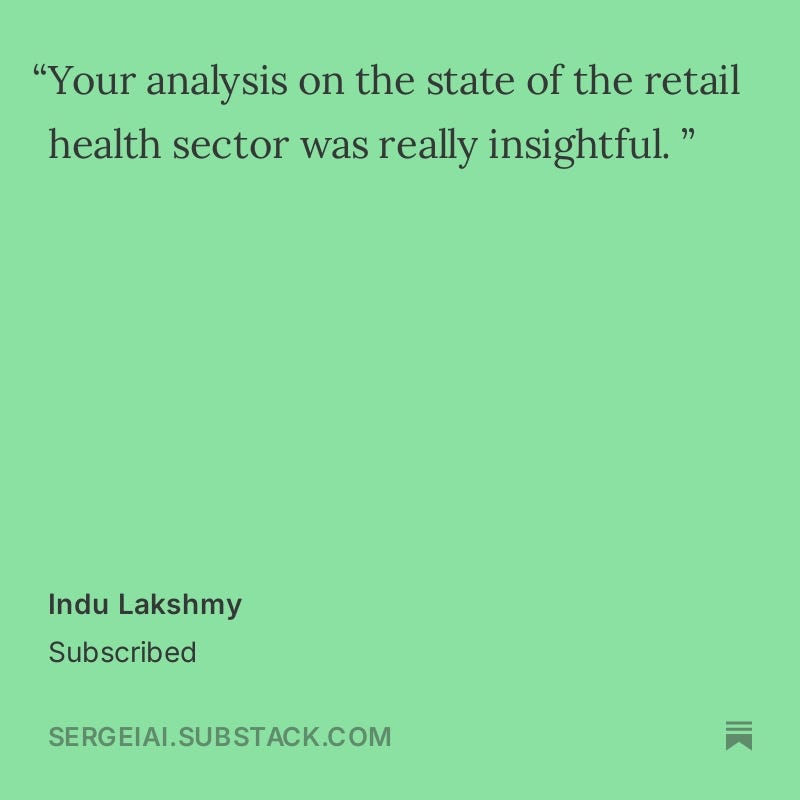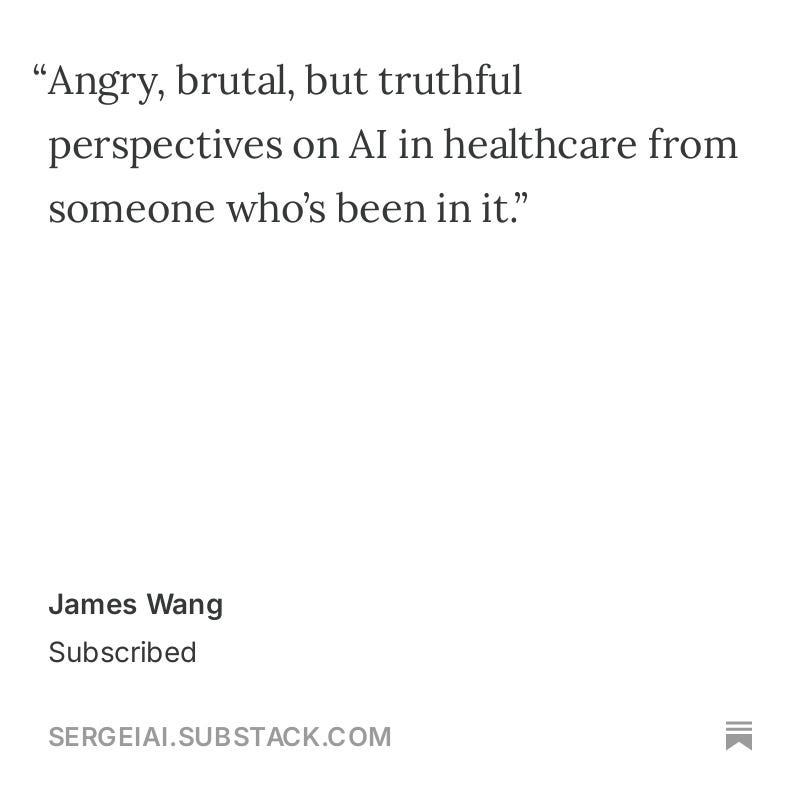🎉 1-Year Anniversary of AI Health Uncut! 🎉
I’m breaking down the biggest wins, lessons, and yes, the occasional punch in the gut from the past 12 months. If you haven't devoured all 50 of my articles, prepare to be shocked.
Wow! It’s been a year already. Feels like I just hit “Publish” on my first Substack post yesterday.
Time flies when you’re tearing down broken systems. Looking back, a lot has been accomplished, but there’s still a mountain to climb.
I launched this newsletter with 3 goals:
1️⃣ Fix U.S. healthcare. Not an option, a necessity.
2️⃣ Deliver the brutal truth about healthcare—technology, AI, innovation, investments, fraud—because too many people are scared to.
3️⃣ Offer value that my readers can’t just pull from ChatGPT. (Which, by the way, is probably why ChatGPT is itching to train on my content. 😉)
I hold other healthcare writers to the same high standards.
Let’s keep pushing.
I don’t have sponsors. I don’t have advertisers. I don’t have bosses. Why? Because they’re the silent killers of innovation. They suffocate creativity and drown out the raw, unfiltered mission of this newsletter: to fix healthcare.
I write with no strings attached—just the brutal truth drawn from my experience and expertise.
Now, because I don’t have sponsors or advertisers, I owe a massive debt of gratitude to my paid subscribers and especially the Founding Members. These folks aren’t just supporting my work. They’re covering the tab for those who can’t afford a paid subscription—like students.
I believe in fair compensation for every piece of work. So, to those who’ve stepped up as paid subscribers: thank you. 🙏 If you’re not a paid subscriber yet and you want my relentless research and analyses to continue for another 12 months, 24 months, 36 months, and more, consider joining the ranks:
I was stunned to learn that Substack lets you import Excel files with emails, all for the sake of spamming unsuspecting people. This is not just bad. It’s a toxic practice that needs to end now. I hope you’ll back me up on this. No one should have the right to invade someone’s inbox, effortlessly and without their consent.
I’m proud to say that every single person getting my newsletter chose to subscribe. And if they ever want out, they can unsubscribe with a single click. That’s how it should be—no tricks, no spam.
Exactly one year ago, on August 27, 2023, I set out to publish bi-weekly (once every two weeks). Turns out, I ended up publishing weekly. Some people churn out content several times a week. Honestly, I have no clue how they pull it off. For the high-quality research I aim for, I need time—days, weeks, months even. Take my Babylon Health fraud investigation, for example. That took months to unravel.
Over this past year, we’ve done a lot. AI model reviews, fraud investigations, countless digital health industry deep dives, navigating new policies from CMS and the regulators, exposing private equity and venture capital scams, and doing multiple interviews. I also published an academic paper on best practices for implementing AI in clinical settings. It’s a unique manual where I absorbed wisdom from around 200 top academic publications and added my own insights on how to ensure AI in healthcare is ethical and responsible.
To be honest, when I started writing a year ago, I didn’t expect such an overwhelming response from so many people.
Here’s just a small sample of some of the comments I’ve received.
I’m flattered, and I’m honored. Thank you! 🙏
But let’s get real—I need more criticism. Criticism and skepticism are the engines that drive improvement and innovation. Praise alone? That just creates an Emperor with No Clothes situation—the kind we currently see in venture capital. (The Truepill debacle hit me like a sledgehammer. I genuinely believed Truepill was a beacon in the murky waters of digital health. Here’s the thing with private companies: you only get the handpicked info—the sanitized version VCs want you to see.)
I aim to instigate and to provoke discussion in every piece I write, often by playing devil’s advocate.
I don’t give a damn about subscription trends. I don’t obsess over them. If people find value in what I’m offering, they’ll subscribe and spread the word. But wasting time on SEO optimization and all that crap? That’s not my game.
What I do care about is finding allies in my mission to fix U.S. healthcare.
That said, this recent drop in email open rates from 50% to 44% has me thinking. If you’re not opening the emails, why bother subscribing in the first place? Then again, I’m guilty too—subscribing to way too much. The last thing I want is to clutter up your inbox with spam.
I now want to highlight the most crucial insights, hard-hitting analyses, and relentless investigations I’ve uncovered over the past year:
🔵 I was upset that there wasn’t a unified framework for best practices in clinical settings. So I did what any frustrated academic would do—I took matters into my own hands. I spent months buried in over 200 academic papers, survived the grueling peer review massacre, and finally published a paper on Best Practices of AI in Healthcare. If we’re serious about letting AI help U.S. healthcare, we need to make damn sure we do it ethically and responsibly. I break down the whole journey in this Substack article.
🔵 I’ve pulled together nearly 100 recent digital health failures, and the common themes are glaring. These aren’t just mistakes—they’re wake-up calls. If we want to avoid screwing up the future of healthcare for our kids, it’s time to take a hard look and learn from these colossal disasters.
🔵 I’ve dissected the corpses of digital health failures and extracted some cold, hard truths: the death of Olive AI, the Teladoc-Livongo debacle—a masterclass in vaporizing wealth, transferring billions from Teladoc’s retail investors to 7wireVentures and other VCs. The final nail in the coffin for telehealth as we know it, highlighted by Optum’s telehealth disaster and Amwell’s slow death spiral. Oscar Health and Clover Health are proving that insurance can still be a graveyard. Walmart Health? A Titanic that never left port. And let’s not forget Cue Health—taken out by a textbook illegal VC pump-and-dump scheme. Even Epic, the healthcare IT fortress, is vulnerable to Russian hackers. Welcome to the brutal reality of digital health.
🔵 As a digital health founder, I dodged the SPAC attack when it was raining down on the industry a couple of years back. The SPAC craze was a glorified Ponzi scheme, exploiting Covid chaos while the U.S. government had its back turned. The SEC eventually woke up, but not before the ‘SPAC King’ himself, Chamath Palihapitiya, cashed in and turned into an overnight billionaire by cheating retail investors out of their hard-earned savings.
🔵 I conducted critical reviews of state-of-the-art (SOTA) medical AI models, including Med-PaLM 2 and Med-Gemini. And despite the flaws I meticulously laid out, these tools are still game-changers for clinicians. Yes, they’re worth it.
🔵 I’ve identified 10 obstacles the healthcare industry must overcome if we want physicians to trust and adopt AI in medicine.
🔵 I spent months on my Babylon Health investigation, and what I found was staggering. 16 signs of potential fraud, 17 outright lies from Ali Parsa, Babylon’s CEO, and 22 hard lessons for the digital health industry. But the most jaw-dropping moment? In early 2022, CMS handed Babylon a check for $1 billion(!)—money that U.S. taxpayers entrusted them with! Why? Because some slick salesman named Ali Parsa—who had barely set foot in the U.S.—convinced them it was a good idea—before Babylon had even done anything. All on the back of promises about a more “efficient” capitated model. Meanwhile, CMS keeps slashing physician reimbursement year after year! Sure enough, Ali Parsa burned through the cash, and just 16 months later, Babylon filed for bankruptcy. It’s beyond absurd—it’s nauseating. And where’s Ali Parsa now? Out of the country, with the FBI sitting on their hands. The Babylon Health debacle is a stark reminder: in healthcare, beware the sweet-talking salesman with zero substance.
🔵 I made 7 predictions for digital health in 2024, and dropped a bombshell: “By and large, there have been no innovations in digital health.” I went further, calling most digital health companies “tech parasites”. The backlash? Massive. And that's exactly what I wanted. Stirring the pot might just wake up a few people, especially the LPs who pour money into this space. Maybe, just maybe, they'll start paying attention to where their dollars are going. It's time for venture capital to flow to real innovators and problem solvers, not just the loudest voices in the room.
🔵 I’ve been banging on the doors of Congress, targeting those who supposedly care about healthcare, to expose the predatory practices of private equity in the sector. And by the way, venture capital has jumped into the fray, too. Turns out, private equity has been playing a rigged game for decades, thanks to a massive legal loophole. Here’s the kicker:
The free market is only free when the rules are fair for everyone. When I invest in a stock, and it goes up 100%, I make 100%. If it tanks by 100%, I lose 100%. Simple, right? So why does private equity get to win big when a hospital is thriving but dodge the bullet when it crashes? When things go well, it’s “my brilliant investment”. When it all falls apart, it’s “not my money, I just borrowed it.” This is the “PE Call”, and it should be illegal.
The real issue here is ownership during leveraged buyouts, not the argument that hospitals shouldn’t get funding. No one’s against hospitals receiving capital—whether from private equity or otherwise. But the game needs to be fair.
Unfortunately, my congressman, Tom Suozzi, seems more focused on his political career than fixing this mess. We thought we hit the jackpot when we finally booted George Santos from Long Island, but Suozzi isn’t exactly delivering results either. I’ve even thrown in a public comment on an FTC inquiry about private equity’s chokehold on healthcare, following the Steward Health fiasco. But I won't bother with the SEC or the FBI. I know how they treat whistleblowers—it’s a nightmare.
🔵 Case in point: Hemant Taneja, CEO of General Catalyst. This guy pulls off a stunt right out of the Gordon Gekko handbook—bought a hospital he couldn’t afford by borrowing a cool billion and dumping the debt onto the hospital’s balance sheet. To pull off this magic trick, he created HATCo, a shell company hilariously claimed to stand for “Health Assurance Transformation Corporation”. But let’s be real. The name is likely a nod to Hemant Taneja’s own initials. It’s straight out of the playbook of those narcissistic S&L CEOs from the 1980s who loved plastering their initials on their companies’ market trading tickers, much like a certain former president.
In my public comment to the Federal Trade Commission (FTC), Department of Justice (DOJ), and Department of Health and Human Services (HHS) about Consolidation in Health Care, I argue that what Mr. Taneja and General Catalyst are doing is a Ponzi scheme. By creating a shell company to dodge potential bankruptcy inquiries and shoving all this debt onto someone else’s books, they’re playing a high-stakes game of financial Jenga.
🔵 I’ve pulled back the curtain on healthcare’s most egregious oligopolies: Cigna’s CEO pocketing a cool $1 billion, UnitedHealth skimming $50 billion off Medicare with upcoding fraud, and Walgreens making the worst deal in its 123-year history with the VillageMD acquisition. And let’s not forget UnitedHealth’s AI, which managed to prioritize care for healthier white patients over sicker Black patients, screwing over 100 million lives in the process.
🔵 I’ve exposed how corporate media, especially Forbes, is in bed with VC bros and neglects the real problems in healthcare. Forbes seems more interested in promoting the biggest and most influential venture capital firms based on their brand names rather than their actual impact. I break down why Forbes’ VC rankings are fundamentally flawed.
🔵 I’ve developed a 21-point Health AI IPO Checklist. It’s your ultimate guide to separating the unicorns from the roadkill in the digital health IPO parade.
🔵 Most importantly, I’ve been pushing my readers—everyone, really—to join me in fixing American healthcare. The system is a dumpster fire, and to extinguish it, we need your insights, especially on the latest bureaucratic moves from CMS and HHS. You can’t fix what you don’t understand, and right now, our healthcare system is a masterclass in dysfunction.
We’ve covered a lot of ground over these 12 months, but let’s be real: U.S. healthcare is still in deep sh*t. Until it isn’t, we keep grinding.
Your comments and thoughts are the fuel that keeps this engine running. So, do you think my work with AI Health Uncut is moving the needle? What needs to be improved?
I’m in this for the long haul, committed to fixing U.S. healthcare through AI and tech. Math, statistics, AI, and economics are my passion. But healthcare is my mission.
Here’s to many more years of pushing the needle forward! 🥂 Thanks for your support! 🙏
👉👉👉👉👉 Hi! My name is Sergei Polevikov. I’m an AI researcher and a healthcare AI startup founder. In my newsletter ‘AI Health Uncut’, I combine my knowledge of AI models with my unique skills in analyzing the financial health of digital health companies. Why “Uncut”? Because I never sugarcoat or filter the hard truth. I don’t play games, I don’t work for anyone, and therefore, with your support, I produce the most original, the most unbiased, the most unapologetic research in AI, innovation, and healthcare. Thank you for your support of my work. You’re part of a vibrant community of healthcare AI enthusiasts! Your engagement matters. 🙏🙏🙏🙏🙏















